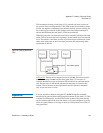
Appendix D Quality of Service Guide
Configuration
StorNext 3.1.3 Installation Guide 137
Configuration
The primary configuration for QOS is in the FSM configuration file. No
client configuration is required, although there is a QOS tuning
parameter that can be specified when the file system is mounted.
Unit of I/O 4
Real-time I/O is based on well-formed I/O. This means that for the
purposes of determining bandwidth rates, well-formed I/O is
characterized as being a stripe width in size. This makes the best
utilization of the disks in the stripe group and maximizes the transfer
rate. Internally, non-real-time I/O is tracked by number of I/O
operations per second. An I/O operation is a minimum of a file system
block size, and a maximum of the file system block size multiplied by the
stripe breadth
(FsBlocksize * StripeBreadth).
FsBlockSize <= I/O <= (FsBlocksize * StripeBreadth)
Converting MB/sec to I/O/
sec 4
Typically, it is easier to qualify an I/O subsystem in terms of MB/sec that
can be sustained. However, internally the file system tracks everything
on an I/O/sec basis. Note that the file system tracks only non-real-time I/
O (that is, it gates only non-real-time I/O). An I/O is a minimum of the
file system block size, and is typically the point at which the file system
hands the request off to the disk driver (
IoCallDriver in Windows, or a
strategy call in UNIX).
The file system counts the number of I/Os that have taken place during a
given second. If the number exceeds that which is allotted, the request is
pended until I/O becomes available (typically in the next second). I/O is
honored in FIFO fashion; no priority is assigned.
To convert between I/Os and MB/sec, SNFS uses a somewhat unique
formula that quantifies I/O as well-formed. The rationale behind this is
due to the way in which many video applications make real-time I/O
requests. To optimize the disk subsystem, real-time I/Os are well-formed
so they saturate the disks. In SNFS terminology, this would be an I/O
that covers all of the disks in a stripe. This can be expressed as follows:


















